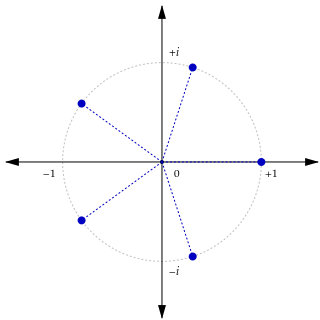In mathematics, a generic polynomial refers usually to a polynomial whose coefficients are indeterminates. For example, if a, b, and c are indeterminates, the generic polynomial of degree two in x is 
However in Galois theory, a branch of algebra, and in this article, the term generic polynomial has a different, although related, meaning: a generic polynomial for a finite group G and a field F is a monic polynomial P with coefficients in the field of rational functions L = F(t1, ..., tn) in n indeterminates over F, such that the splitting field M of P has Galois group G over L, and such that every extension K/F with Galois group G can be obtained as the splitting field of a polynomial which is the specialization of P resulting from setting the n indeterminates to n elements of F. This is sometimes called F-generic or relative to the field F; a Q-generic polynomial, which is generic relative to the rational numbers is called simply generic.
The existence, and especially the construction, of a generic polynomial for a given Galois group provides a complete solution to the inverse Galois problem for that group. However, not all Galois groups have generic polynomials, a counterexample being the cyclic group of order eight.

In mathematics, an abelian group, also called a commutative group, is a group in which the result of applying the group operation to two group elements does not depend on the order in which they are written. That is, the group operation is commutative. With addition as an operation, the integers and the real numbers form abelian groups, and the concept of an abelian group may be viewed as a generalization of these examples. Abelian groups are named after early 19th century mathematician Niels Henrik Abel.
In mathematics, a finite field or Galois field is a field that contains a finite number of elements. As with any field, a finite field is a set on which the operations of multiplication, addition, subtraction and division are defined and satisfy certain basic rules. The most common examples of finite fields are given by the integers mod p when p is a prime number.
In mathematics, particularly in algebra, a field extension is a pair of fields such that the operations of K are those of L restricted to K. In this case, L is an extension field of K and K is a subfield of L. For example, under the usual notions of addition and multiplication, the complex numbers are an extension field of the real numbers; the real numbers are a subfield of the complex numbers.
In mathematics, in the area of abstract algebra known as Galois theory, the Galois group of a certain type of field extension is a specific group associated with the field extension. The study of field extensions and their relationship to the polynomials that give rise to them via Galois groups is called Galois theory, so named in honor of Évariste Galois who first discovered them.

In mathematics, Galois theory, originally introduced by Évariste Galois, provides a connection between field theory and group theory. This connection, the fundamental theorem of Galois theory, allows reducing certain problems in field theory to group theory, which makes them simpler and easier to understand.

In mathematics, more specifically in the field of group theory, a solvable group or soluble group is a group that can be constructed from abelian groups using extensions. Equivalently, a solvable group is a group whose derived series terminates in the trivial subgroup.
In mathematics, the Abel–Ruffini theorem states that there is no solution in radicals to general polynomial equations of degree five or higher with arbitrary coefficients. Here, general means that the coefficients of the equation are viewed and manipulated as indeterminates.

In mathematics, a root of unity, occasionally called a de Moivre number, is any complex number that yields 1 when raised to some positive integer power n. Roots of unity are used in many branches of mathematics, and are especially important in number theory, the theory of group characters, and the discrete Fourier transform.
In field theory, a branch of algebra, an algebraic field extension is called a separable extension if for every , the minimal polynomial of over F is a separable polynomial. There is also a more general definition that applies when E is not necessarily algebraic over F. An extension that is not separable is said to be inseparable.
In field theory, the primitive element theorem states that every finite separable extension is simple, i.e. generated by a single element. This theorem implies in particular that all algebraic number fields over the rational numbers, and all extensions in which both fields are finite, are simple.
Chebotarev's density theorem in algebraic number theory describes statistically the splitting of primes in a given Galois extension K of the field of rational numbers. Generally speaking, a prime integer will factor into several ideal primes in the ring of algebraic integers of K. There are only finitely many patterns of splitting that may occur. Although the full description of the splitting of every prime p in a general Galois extension is a major unsolved problem, the Chebotarev density theorem says that the frequency of the occurrence of a given pattern, for all primes p less than a large integer N, tends to a certain limit as N goes to infinity. It was proved by Nikolai Chebotaryov in his thesis in 1922, published in.
In Galois theory, the inverse Galois problem concerns whether or not every finite group appears as the Galois group of some Galois extension of the rational numbers . This problem, first posed in the early 19th century, is unsolved.
In mathematics, specifically the algebraic theory of fields, a normal basis is a special kind of basis for Galois extensions of finite degree, characterised as forming a single orbit for the Galois group. The normal basis theorem states that any finite Galois extension of fields has a normal basis. In algebraic number theory, the study of the more refined question of the existence of a normal integral basis is part of Galois module theory.
In mathematics, the fundamental theorem of Galois theory is a result that describes the structure of certain types of field extensions in relation to groups. It was proved by Évariste Galois in his development of Galois theory.
In number theory, Hilbert's irreducibility theorem, conceived by David Hilbert in 1892, states that every finite set of irreducible polynomials in a finite number of variables and having rational number coefficients admit a common specialization of a proper subset of the variables to rational numbers such that all the polynomials remain irreducible. This theorem is a prominent theorem in number theory.
In mathematics, the Artin–Hasse exponential, introduced by Artin and Hasse (1928), is the power series given by
In mathematics, an algebraic number field is an extension field of the field of rational numbers such that the field extension has finite degree . Thus is a field that contains and has finite dimension when considered as a vector space over .
In mathematics and computer algebra the factorization of a polynomial consists of decomposing it into a product of irreducible factors. This decomposition is theoretically possible and is unique for polynomials with coefficients in any field, but rather strong restrictions on the field of the coefficients are needed to allow the computation of the factorization by means of an algorithm. In practice, algorithms have been designed only for polynomials with coefficients in a finite field, in the field of rationals or in a finitely generated field extension of one of them.
In Galois theory, a discipline within the field of abstract algebra, a resolvent for a permutation group G is a polynomial whose coefficients depend polynomially on the coefficients of a given polynomial p and has, roughly speaking, a rational root if and only if the Galois group of p is included in G. More exactly, if the Galois group is included in G, then the resolvent has a rational root, and the converse is true if the rational root is a simple root. Resolvents were introduced by Joseph Louis Lagrange and systematically used by Évariste Galois. Nowadays they are still a fundamental tool to compute Galois groups. The simplest examples of resolvents are
In algebra, the fixed-point subring of an automorphism f of a ring R is the subring of the fixed points of f, that is,






















